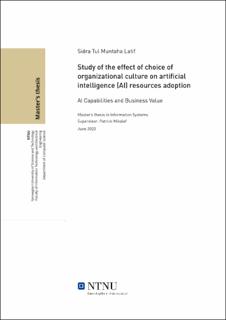| dc.description.abstract | Over the last decade, continuous improvement in the high-performance computing systems has provided a significant boost to the inclusion of artificial intelligence (AI) practices to businesses. However, only a handful of organizations truly knows how the transformation affected their business market competition, along with the understanding of the real barriers to its adoption. Many organization finds it hard to oversee the general overview of the present development of AI capabilities. It is understandable to some extent considering the AI technology is complex, and still in its early phase of implementation. While most of the previous work on AI has been conducted from a technical viewpoint, there is a significant gap that still needs to be filled concerning AI impact on business organizations. Usually, the adoption of technology is what each business is willing to introduce through its organizational structure; empirical evidence of its technology adoption on the performance of business firms is still lacking. There is limited scientific literature that helps organizations to understand the real barriers and challenges to firms that have adopted AI. The aim of the present work is to cover the research gap with an empirical study to help identify the main challenges and barriers to businesses facing through the adoption of AI technology. In the present work, a research study is conducted in the form of an online survey aimed at organizations that have adopted AI or in a phase of its adoption into their work routine. The present study conducts the analysis using 242 surveys obtained from professionals working with the technology in established organizations. The results of the survey have been studied through statistical methods of k-means clustering analysis and One-Way ANOVA to find patterns in the obtained data. Particular emphasis has been placed to evaluate how organizations exhibit common strategies of culture and AI resources data. From the analysis of results, a noteworthy finding is that the business organizations having better organizational capabilities of the rationale and hierarchical techniques are better off with handling AI (tangible, intangible, human) resources. | |
